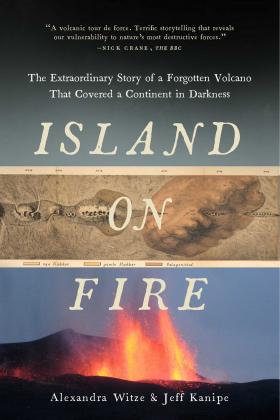By Karina Wetherbee.
Island on Fire, by Alexandra Witze and Jeff Kanipe
In today’s modern, hyper-connected world, very little happens without some cable news journalist reporting upon it, or some individual posting an update with a selfie. Cameras are situated on mountain peaks, above eagles’ nests, where fat bears catch fish, and even on the flanks of highly active volcanic craters.
Iceland is famous for its fiery nature, and the world can watch, via livestream, as one volcano after another takes a turn spitting and spewing into the sky. But in the fascinating book, Island on Fire, science authors Alexandra Witze and Jeff Kanipe focus on a time in history when there was little awareness or understanding of volcanos or how they could impact the world. The book centers, in particular, on the June 1783 eruption of Laki in that remote Atlantic country, which had a profoundly devastating and altering impact on much of the world for years to come.
The book is a fascinating balance of science and history, alternating between a contextual analysis of Laki’s place in the history of volcanic eruptions around the world, and the calamitous immediate aftermath during that 1783 event, which, they write, “changed both the history of Europe and the history of science.”
The authors provide an important Icelandic figure as the lynchpin for their historical storytelling. A local 18th century clergyman, who also dabbled in science, was a prolific chronicler, and his daily diary became significant in documenting Laki’s long eruption and its destructive aftermath on his congregation.
His life story offers a fascinating anchor for the main character of the book, the volcano, itself.
Laki’s stratosphere-reaching ash plume was laced with massive amounts of sulfur dioxide, fluorine, and chlorine, so beyond its obvious local impact, and given the general flow of the jet stream, the toxic cloud easily reached the next landmass downwind, which happened to be Europe. The arrival of the ash and gas “dimmed the sun and instilled panic across the continent.” The lingering climatic effects were even felt in North Africa and far Asia.
Some scholars, they write, even attribute the “long-lasting hunger and social unrest” that followed as some of the kernels that birthed the discontent that eventually fueled the French Revolution.
Though much of the book looks back on the aftermath of the eruption, the authors conclude the volcanic study with the supposition of a repeat performance by Laki. Given how the world has changed, what would a similar eruption present itself like in our modern global economy and human population? Would it be like the unpronounceable Eyjafjallajökull of 2010, which was initially viewed as an Instagram-worthy “tourist eruption” but which eventually shut down airspace and had a huge impact on air travel? Or even more devastating? What’s clear from their fascinating book is that volcanoes shape and destroy, and there is very little humans can do but stand in awe — at a safe distance — and marvel.
Karina Wetherbee, a Keystone, Colorado native, and part of the long-time Crestone Dercum family, has been a writer since 2004, with a memoir and a novel. She has been a professional photographer and watercolor artist for many years. She wrote regular book review columns for The Summit Daily and Vail Daily, and is now contributing monthly book reviews to The Crestone Eagle.


